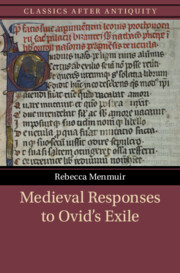Book contents
- Medieval Responses to Ovid’s Exile
- Classics after Antiquity
- Medieval Responses to Ovid’s Exile
- Copyright page
- Contents
- Acknowledgements
- Quotations, Translations and Transcriptions
- Abbreviations and Conventions
- Introduction
- Part I Responding to Exile
- Part II Becoming the Exile
- References
- Index of Manuscripts
- General Index
- References
References
Published online by Cambridge University Press: 27 May 2025
- Medieval Responses to Ovid’s Exile
- Classics after Antiquity
- Medieval Responses to Ovid’s Exile
- Copyright page
- Contents
- Acknowledgements
- Quotations, Translations and Transcriptions
- Abbreviations and Conventions
- Introduction
- Part I Responding to Exile
- Part II Becoming the Exile
- References
- Index of Manuscripts
- General Index
- References
Information
- Type
- Chapter
- Information
- Medieval Responses to Ovid's Exile , pp. 222 - 246Publisher: Cambridge University PressPrint publication year: 2025
